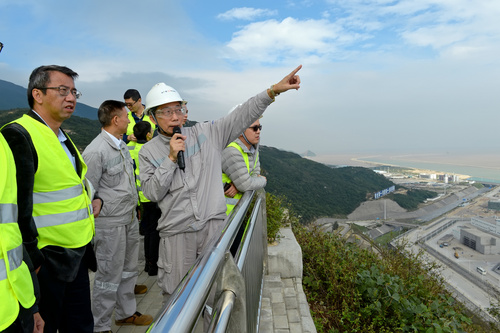 Members of the joint task group for nuclear safety are further briefed on the planning of Taishan Prefecture’s nuclear power plant, during a visit there.
Members of the joint task group for nuclear safety are further briefed on the planning of Taishan Prefecture’s nuclear power plant, during a visit there.
The joint task group for nuclear safety today (Thursday) paid a visit to the nuclear power plant in Taishan Prefecture, Guangdong Province, in order to gain a better understanding of its facilities and how the site has been planned. The plant has not yet started operation, according to information provided to the Government. The Government pays great attention to the public’s interest in safety issues regarding nuclear energy generating facilities located near Macao. It is actively seeking steps to allay any public concern regarding the safety of the Taishan nuclear facility in particular. Today’s visit was led by the Coordinator of the Security Forces Coordination Office, Mr Choi Lai Hang. The visiting group comprised members from a number of public departments and several Macao associations. The visit received support from: relevant ministries and departments of the Central Government; the Guangdong provincial authorities; and the Taishan Nuclear Power Joint Venture Co., Ltd. During the visit, a representative from the company stated the plant had already established an emergency response area as part of its nuclear emergency plan. According to relevant regulations, this area was divided in several zones: a pre-evacuation zone included the area within a five-kilometre radius of the plant; a secondary zone extended to 50 kilometres around the plant, and provisions for this area in case of an unscheduled nuclear event included mostly safety checks on any food produced in the area, and on any water sourced there. The radius of the latter safety zone is in line with the strictest requirements under existing regulations. Were an unscheduled event to occur that was categorised as of the most serious type, there would be no need to evacuate any area outside a 20-kilometre radius of the plant, said the representative. Macao is 67 kilometres away from Taishan. This means no part of Macao would require evacuation even in the case of the most serious category of unscheduled event at Taishan. According a seven-level scale for unscheduled events – as defined by the International Atomic Energy Agency – the first three levels are classified as “incident”, and levels four to seven are defined as “accidents”. In China, there has been no event categorised as more serious than level two. During the visit to the nuclear plant, the representative said the firm would – as always – comply with national laws and standards for developing nuclear power facilities. At the same time, the company pledged to enhance safety management at its facilities and maintain strict quality control regarding the equipment used in the Taishan project, in order to ensure the safety of the nuclear power plant. In addition, the SAR Government was working closely with Guangdong’s Emergency Management Office, regarding the establishment of a mechanism for regular communication between the provincial authorities and Macao. This was in order to facilitate exchanges relating to safety matters and in order better to respond to any public concern. Once the mechanism had been set up, it would facilitate further visits from Macao observers – including various sectors of the community – in order to enhance the public’s understanding regarding development of nuclear power at Taishan. The Government is analysing if there is a need to update Macao’s emergency response measures in order to cope with any possible unscheduled nuclear event in neighbouring areas. In June, the Government invited mainland experts in nuclear energy to Macao, to enable them to provide further details of the construction of the Taishan plant, and to share their knowledge with the public, regarding nuclear safety.
View gallery


